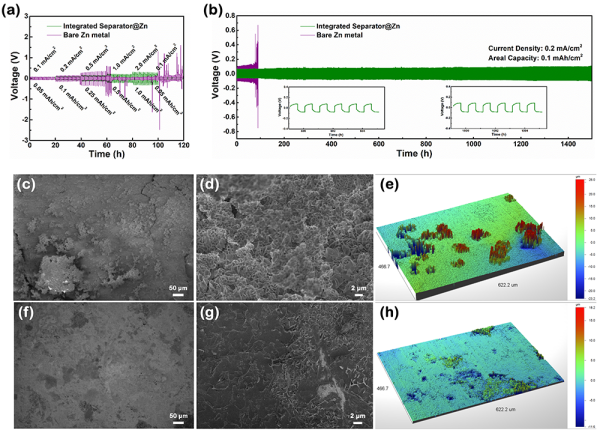The traditional electrochemical energy storage device configuration is mainly constructed by sandwiching a diaphragm between two electrodes and injecting electrolyte, that is, the diaphragm is located between the two electrodes, but the three are in a state of being separated from each other. When the device is in a bent state, the above-mentioned three components are prone to relative displacement or separation between them due to different radii of curvature, which in turn leads to a sharp increase in contact resistance, electrical/ion transmission retardation, and deterioration of electrochemical performance. Therefore, the traditional component-separated device configuration has great limitations when expanding the device in the direction of high flexibility. The integrated configuration refers to the integration of the main components (positive, negative, and diaphragm) of the energy storage device into a whole through strong interaction, so that the adjacent components can be continuously and seamlessly connected, and the ions in the bending state are guaranteed. And the stable transmission of electrons. Therefore, the integrated device structure design has become a key to solving the problem of limited flexibility caused by the traditional separated configuration, and it is also of great significance for the rational structure optimization of flexible energy storage equipment. Researchers from the Institute of Physics, Chinese Academy of Sciences/Beijing National Research Center for Condensed Matter Physics, Advanced Materials and Structural Analysis Laboratory researchers have developed a supercapacitor with an integrated structure based on the development of a supercapacitor with an integrated structure for electrochemical energy storage devices. The expansion of functional directions such as flexibility provides new ideas. Recently, researchers have taken the integrated configuration design of high-safety water-based zinc-ion batteries as their starting point, and built an integrated water-based zinc-ion battery by integrating the various components of the zinc-ion battery into one (Figure 1). In the design of this integrated zinc-ion battery, the highly flexible and tough polyamide microporous membrane is formed by the tight integration of the coating on the surface of the zinc negative electrode, and the in-between is composed of zinc trifluoromethanesulfonate and polyamide. The sub-component coating is sandwiched between the zinc negative electrode and the polyamide separator, which can play multiple roles: while bonding the zinc negative electrode and the polyamide separator, it also plays a good role in the growth of dendrites and the occurrence of side reactions on the negative electrode Inhibition (Figure 2). The positive electrode part adopts α-MnO2 nanowires and multi-walled carbon nanotubes to form an interconnected network structure supported on the polyamide separator. The entire positive electrode layer itself acts as a current collector, eliminating additional inactive components and not only realizing the thinness of the entire electrode , Which can improve the mass/volume energy density of the entire device. In the final integrated configuration, there is a strong interaction between adjacent component layers, which ensures stable interface contact and forms a seamless connection at the same time, avoiding the relative displacement or relative displacement of each layer component in the bending state. Separation not only improves the rate performance and cycle stability (capacity retention after 5000 cycles reaches 89.4%) (Figure 3), but also exhibits excellent electrochemical stability and flexibility (capacity retention after 1000 cycles of bending) Rate>90%) (Figure 4). The method used in this work is simple and easy to implement, and has high compatibility with the existing battery manufacturing process; while ensuring the inherent high safety and high ion conductivity of the water-based zinc-ion battery, it can solve its problems. Facing scientific problems such as dendrite growth and bending limitation, it provides an effective structural design example for the practical application of high-safety, high-flexibility and long-life water-based batteries. The relevant research results were published in Nano Energy with the title An integrated configuration with robust interfacial contact for durable and flexible zinc ion batteries. This work has been supported by the Ministry of Science and Technology, the National Natural Science Foundation of China, and the Chinese Academy of Sciences Strategic Leading Science and Technology Project (Class A). Light-weightness and more resistance to earthquakes and strong winds.
Shorter construction period with the help of modularity and error-free prefabrication of building elements.
Environment-friendly thanks to reusable steel members and minimized wastes by efficient usage of materials in the factory. Steel Garage Buildings,Steel Structure Workshop,Steel Structure Portal Frame,Steel Portal Frame And Truss Foshan TianPuAn Building Materials Technology Co.,Ltd. , https://www.tpa-prefabhouse.com
Figure 1. Schematic comparison of the structure of the integrated configuration and the traditional separated configuration of the water-based zinc ion battery 
Figure 2. Inhibition of integrated configuration on dendritic growth and side reactions of zinc anode 
Figure 3. The electrochemical performance comparison between the integrated configuration and the traditional separated configuration in the button zinc ion battery 
Figure 4. The electrochemical performance and demonstration of the integrated zinc-ion battery under bending
Sustainability and less lifecycle cost thanks to low maintenance costs and highest quality materials, such as galvanized steel.
Functionality, provided by relocatable, replaceable and load carrying walls and efficient usage of the space.
Physics has made progress in the research of integrated configuration of zinc ion batteries
